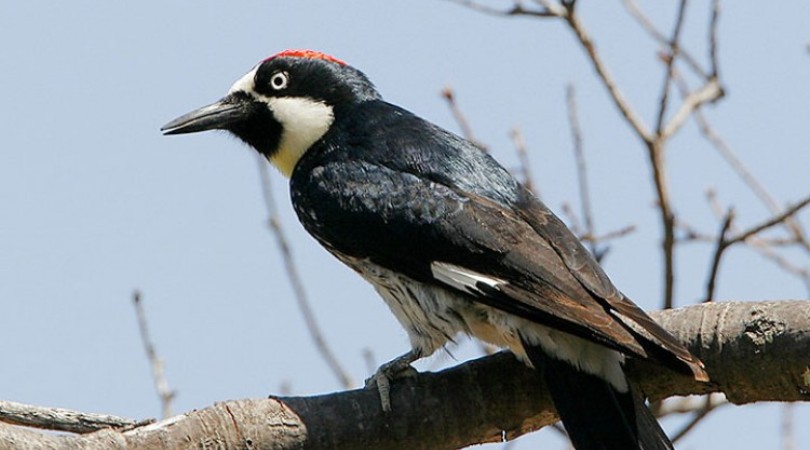Acorn Woodpecker (Melanerpes formicivorus) is a black and white woodpecker with black, white, and red on its head, and small black markings on its flanks.
In their range, a small group of animated black and white woodpeckers making odd laughing sounds is probably this species. We can see then visit feeders, forage in oak trees, and call from tall snags.
Do you ever wonder where you can see this beautiful bird? See this article and learn more about this fun woodpecker species!
On this page
Identification
Male
The male Acorn Woodpecker is a medium-sized woodpecker with a glossy black back, a red patch on top of its head, and pale staring eyes. It also has a bit of black around the base of its long, black beak, and has an ivory or pale, cream-colored throat and front.
Related: Are there any blue woodpeckers?
They have a black chest with some black streaking on their flanks and underparts, a white belly, and a pointed, black tail.
On average, Acorn Woodpeckers are 9 inches long, have a 17.5 inch wingspan, and weigh 2.8 ounces.
Both sexes of this species make the same loud, nasal calls and laughing sounds.
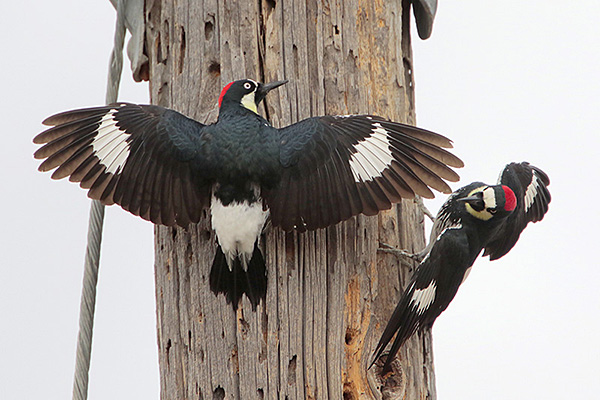
Males have a larger red patch on the top of their heads
Female
Female Acorn Woodpeckers look just like male birds but have a smaller red patch on their head. In males, this patch extends to just above their eyes, whereas, in females, it is only on the back part of the top of the head.
Like the male, the female Acorn Woodpecker has the same glossy black colors and pattern, including a bright white rump patch, and a big white patch on each wing. Those white patches on the rump and wings really stand out in flight.
Similar to other woodpeckers, both male and female Acorn Woodpeckers swoop among trees with bounding, undulating flight.
Vocalizations
Acorns Woodpeckers are very vocal birds that seem to constantly communicate with each other. They make all sorts of nasal and rattling calls, along with a distinctive laughing vocalization. The woodpeckers often make their loud laughing sounds when family members meet with each other. It sounds like, waka waka waka waka.
They also make a short drumming sound with their beaks, and when they see a predator, make karit cut sounds. If an Acorn Woodpecker is caught by a predator, it can even make loud screaming sounds!
Food
Acorn Woodpeckers feed on insects, acorns, sap, nectar, fruit, and small animals. These handsome woodpeckers eat a lot of flying ants, beetles, and larvae. They will also eat small lizards, and various other creatures, even bats, mice, and small birds!
These woodpeckers forage for insects by flying from a high snag to snatch them with their beaks, and picking some bugs from bark.
They feed on nectar by using their bills to probe into flowers, and also drink sap from small holes they make in trees.
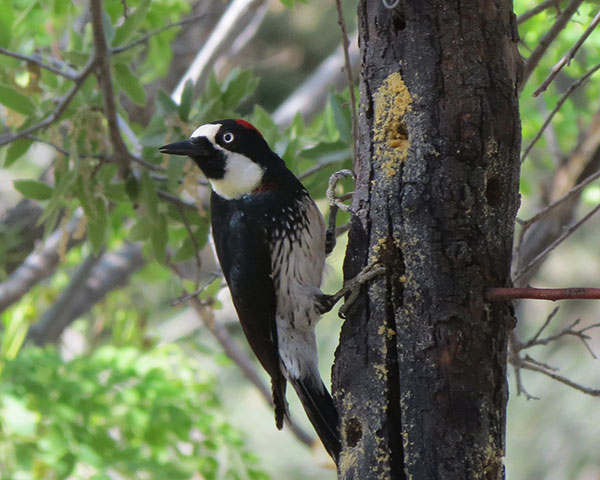
As this woodpecker species forages, if it sees a small bird or other small animals that seem vulnerable, it can quickly move in to catch and kill it with its sharp beak. Like several other woodpeckers, they can also take advantage of bird nests and eat the eggs.
They can also visit feeders that have suet and nuts. Most of all, though, true to its name, this species loves to eat acorns. They forage for this important food item by picking them from trees, one by one. Once in a while, they also fly off with a twig that holds two or three acorns.
Acorn Woodpeckers crack open these nuts by holding them with one of their feet and hacking at it with their beak.
Nesting and Eggs
The Acorn Woodpecker nests in cavities that it excavates in both live and dead trees. Members of a woodpecker family make several cavities for roosting and the breeding female picks one to use as a nest. On average, the cavity is 6 inches in diameter and can be anywhere from 8 inches to more than 2 feet deep.
The nest can be 7 to 60 feet above the ground, and be in all sorts of trees as well as human-made structures. Although they don’t build a nest inside the cavity, the woodpeckers do peck at the walls of the hole so their nest can always have a layer of fresh wood chips at the bottom.
Once the nest is ready, the female woodpecker lays 3 to 6 white eggs that are one inch long and weigh 5.3 grams.
After being incubated for 11 days (by both parents), the babies hatch and are fed insects and bits of acorns by their parents and other members of their woodpecker family.
The young Acorn Woodpeckers leave the nest around a month after hatching but continue to be fed now and then by their parents and older siblings for some time after that.
Current Situation
The Acorn Woodpecker is a common, permanent resident in coastal Oregon and California, and montane areas of New Mexico, Arizona, and western Texas. This woodpecker species also occurs from Mexico to northern Colombia.
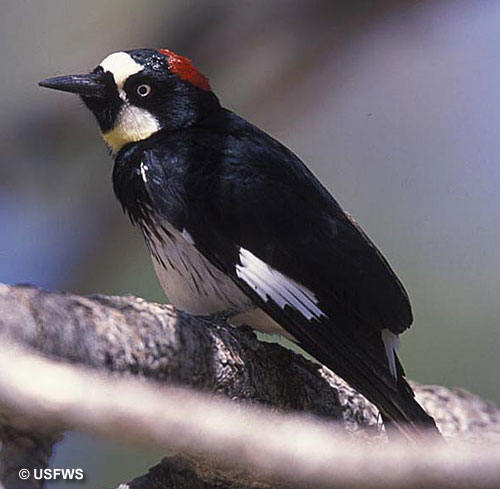
They are listed as Least Concern in the IUCN Red List and are common birds throughout their range.
Acorn Woodpeckers are social birds that can adapt to living with and near people.
However, they are dependent on woodlands with lots of mature oak trees. With that in mind, they have probably declined in areas where oaks have been removed for grazing and urbanization, and can be affected by the cutting of oak trees used for storing acorns.
They could also eventually be affected in areas where oak saplings are grazed or cut, and not allowed to grow. Once, old trees die off, there aren’t any young trees to replace them.
Facts
- Of the 11,000 species of birds, this is the only one with “Acorn” in its name.
- Acorn Woodpeckers are also sometimes called the Clown-faced Woodpecker. It only takes one look at these birds to see why that nickname fits.
- The Acorn Woodpecker is a master at storing acorns. These industrious birds peck holes in trees, fenceposts, buildings, and all sorts of other things to make niches for thousands of acorns. This way, woodpecker families can always have food available during droughts or other challenging situations.
- Unlike many other birds, Acorn Woodpeckers live in complicated family groups that can have several breeding adults. Their children can also stay with them for several years.
- One of the main predators of the Acorn Woodpecker is the Cooper’s Hawk. If an Acorn Woodpecker sees this or other potential predators, it gives a loud alarm call before hitching underneath a branch and keeping still.
- This species often uses the same nesting hole year after year. Once it picks a cavity for nesting, it aggressively defends it from starlings and other birds that nest in tree cavities.
Similar Species
No bird has the same clown-like face as the Acorn Woodpecker. However, there are a few other woodpecker species that live with or near them, and have some similar field marks.
Related: Types of Woodpeckers in North America
White-headed Woodpecker
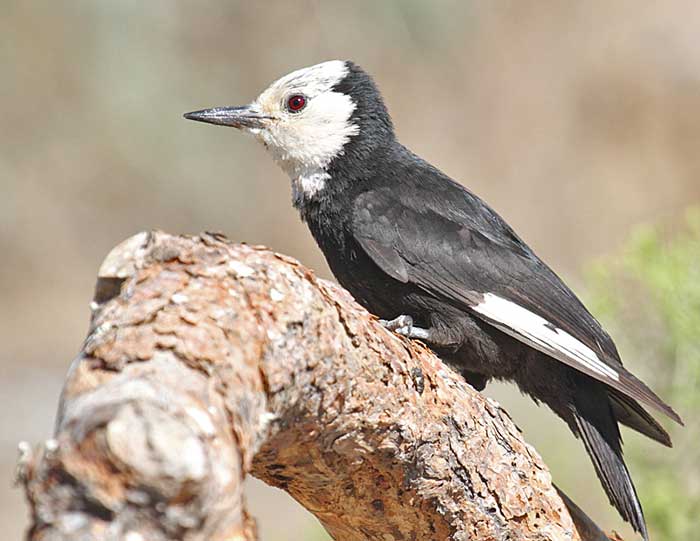
The striking White-headed Woodpecker is the same size as the Acorn Woodpecker and also has white on its head and face. However, the rest of its plumage is mostly black whereas the Acorn Woodpecker has white on its belly and rump. The Acorn also has a larger white patch in its wings and a more patterned, black and white face.
Red-breasted Sapsucker
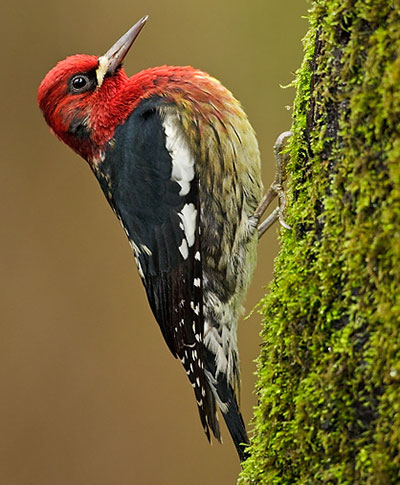
Photograph © Glenn Bartley
In Oregon and California, Red-breasted Sapsuckers often occur with the Acorn Woodpecker. However, it has a mostly red head and a red breast. In addition to having a black and white face, the Acorn Woodpecker also has more white on its rump and wings.
Nuttall’s Woodpecker
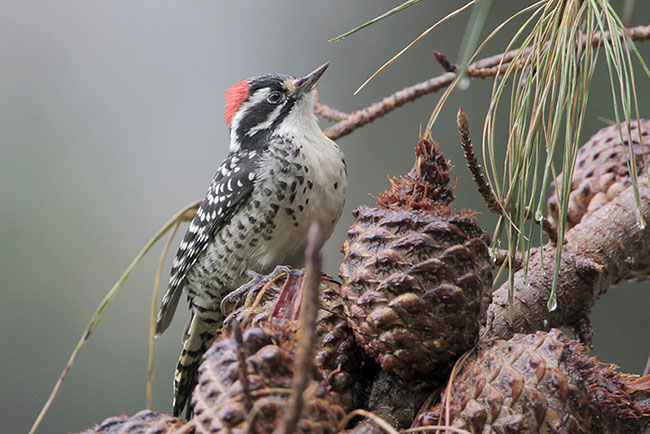
Nuttall’s Woodpecker shares its range with the Acorn and also depends on oak woodlands. It also has black and white on its face but the pattern is quite different from the Acorn Woodpecker. The Nuttall’s is smaller, has black and white barring on its back, and a pale chest.
Frequently Asked Questions
Do Acorn Woodpeckers mate for life?
No, Acorn Woodpeckers do not mate for life. Instead of forming long-term pair bonds, they live in a group made up of several adult birds and their young.
Where does the Acorn Woodpecker live?
The Acorn Woodpecker lives in oak woodlands in parts of the western USA, Mexico, Central America, and northern Colombia.
What trees do Acorn Woodpeckers like?
Acorn Woodpeckers like oak trees. They depend on oaks for their main food (acorns), and also use them for roosting and nesting.
Where do Acorn Woodpeckers go in winter?
Acorn Woodpeckers don’t usually go anywhere in the winter. These birds typically stay in the same region all year long but, if food is scarce, some can migrate to northern Mexico.
What are the predators of the Acorn Woodpecker?
The predators of the Acorn Woodpecker are the Cooper’s Hawk, falcons, Bull Snakes, other snake species, and some types of mammals.
How long do Acorn Woodpeckers live for?
Acorn Woodpeckers can live to be 18 years old in the wild. One bird in captivity lived to be 24 years old.
What is the difference between a Red-headed Woodpecker and an Acorn Woodpecker?
The difference between a Red-headed Woodpecker and an Acorn Woodpecker is the color of the head. The Red-headed Woodpecker has a completely red head while the Acorn Woodpecker has a black and white head with a small red patch on its crown.

